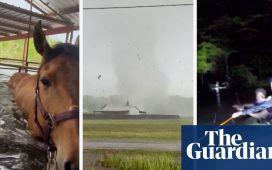Typhoon Hagibis barreled toward Japan on Saturday, its outer bands lashing the country’s eastern coast with heavy rains as cities and evacuation centers braced for landfall. Landslides and flooding were already being reported.
The Japan Meteorological Agency said early Saturday afternoon that sustained winds from the typhoon had been measured at about 100 miles per hour, with gusts of up to 135 m.p.h. The storm, which was moving north toward Japan’s mainland at about 18 m.p.h., was projected to make landfall around dusk in the Shizuoka region on the Izu peninsula southwest of Tokyo.
On Friday, the agency warned that Hagibis could rival the Kanogawa typhoon of 1958, which killed more than 1,200 people in Shizuoka Prefecture and the Tokyo region.
Hagibis so far
By Friday, more than 30,000 households had already lost power in the greater Toyko region, according to the public broadcaster NHK. The weather agency said the southeastern Tokai region could receive as much as 31 inches of rain in a 24-hour period.
As Hagibis approached this week — at one point the equivalent of a Category 5 hurricane, with 160 m.p.h. winds — the Japanese authorities prepared for disruptions in the lives of millions of people. About 1.5 million people live below sea level in eastern parts of Tokyo, and meteorologists warned that as many as five million people might need to be evacuated if waters overwhelmed the levees in low-lying areas.
On Saturday afternoon, NHK reported that local governments had prepared to evacuate more than 10 million people. Already, 432,000 people had been advised to evacuate in the Edogawa ward of Tokyo due to fears of heavy flooding. In Kawasaki City, outside Tokyo, more than 900,000 people had been urged to evacuate, according to NHK.
Around 3:30 p.m., the Japan Meteorological Agency issued an extreme rain warning for Shizuoka, Kanagawa, Tokyo, Saitama, Gunma, Yamanashi and Nagano prefectures — the highest level of warning.
Hundreds of flights were canceled in anticipation of Hagibis, including all of All Nippon Airways’ domestic and international flights from airports in the Tokyo area on Saturday. Japan Railways suspended service in the Tokyo region on Saturday, as well as bullet train service between Tokyo and Osaka.
With the storm bearing down, Rugby World Cup organizers for the first time canceled two matches in Japan. Tourist attractions in Tokyo, including the Disneyland and DisneySea theme parks and the Ueno Zoo, closed on Saturday, as did hundreds of supermarkets and department stores in the city and nearby prefectures.
In Chiba Prefecture, a region still recovering from Typhoon Faxai in September, dozens of people began filing into repurposed schools and other evacuation centers. Faxai destroyed nearly 200 homes and left about 900,000 people without power.
Warnings from experts
On Friday in Tokyo, the secretary general of the World Meteorological Organization warned that tropical cyclones like Typhoon Hagibis were “among the most devastating of all natural hazards.”
Speaking at a meeting with Japanese officials, the secretary general, Petteri Taalas, said that since 1970, seven of the 10 disasters that caused the biggest economic losses around the world had been tropical cyclones. “They wreak havoc with their violent winds, torrential rainfall and associated storm surges and floods,” he said.
This week, Jeff Masters, a meteorologist with the magazine Scientific American, warned that a direct hit on Tokyo Bay could be “a multibillion dollar disaster.” Last year, Typhoon Jebi, the worst typhoon in 25 years, killed 11 people, injured hundreds and caused an estimated $12.6 billion in damage.
What makes a typhoon, cyclone or hurricane
Hurricane Dorian pummeled the Bahamas this year, obliterating homes in its path. Cyclone Idai barreled through Mozambique, Malawi and Zimbabwe, becoming one of the deadliest storms ever recorded in the Southern Hemisphere.
All were tropical cyclones: circular storms that form over warm waters, with very low air pressure at the center and minimum winds of 74 m.p.h. But their location determines what they are called.
Typhoons develop in the northwestern Pacific. Hurricanes form in the North Atlantic, the northeastern Pacific, the Caribbean or the Gulf of Mexico. When a hurricane crosses the international date line in the Pacific, its status changes: Heading west, a hurricane becomes a typhoon, and heading east, a typhoon becomes a hurricane.
Storms that form in the southern Indian Ocean or the South Pacific are called tropical cyclones, and in the northern Indian Ocean simply cyclones. The storms receive their names — like Hagibis or Dorian — according to a list maintained by the World Meteorological Organization.
Storm seasons arrive at different moments in different parts of the world. Typhoons are most common from May to October; hurricane season officially lasts from June 1 to Nov. 30. Hurricane strength is rated on the Saffir-Simpson scale, which is based on sustained wind speed. The Japan Meteorological Agency rates typhoons by sustained wind speed, with three classifications: “typhoon,” “very strong typhoon” and “violent typhoon.”
The Joint Typhoon Warning Center, an American military command based in Hawaii, classifies the storms by four names: “tropical depression,” “tropical storm,” “typhoon” and “super typhoon.”
